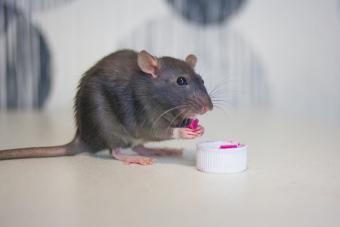
There are all kinds of misunderstandings about rats. Some people may see pictures of rats crawling around in sewers and think all rats are dirty animals. Others may believe that pet rats are exactly the same as wild rats, just with better housing. The truth is that domesticated pet rats - also known as fancy rats - are quite a bit different from the common rats you might see in the wild. These fancy rats make terrific pets!
There are six main differences between fancy and wild rats.
1. Wild Rats Are Not Tame
It all starts with domestication. Fancy rats have been selectively bred for desirable traits over hundreds of generations. They've been kept as pets since the late 19th century in the Western world alone.
Rats can have three litters a year, so there have been roughly 1,200 generations of rats since humans first started breeding them. Even if we only count fancy rats kept as pets since the start of the 20th century, that's still more than 360 generations of rats. For reference, it takes roughly 12 to 14 generations for a wild animal population to be domesticated. Wild rats are feral, have not been bred to be kept as pets, and will not adapt well to a household environment.
Fancy rats were first domesticated in Japan during the Edo Period, starting in the early 1600s. They've been bred heavily since then and are now thoroughly domesticated.
2. Pet Rats Look Different
Fancy rats come in a range of colors and coat patterns, from solid black or white to hooded or dappled, because of selective breeding. Some fancy rats even have unique fur textures, like Rex rats with curly fur. Wild rats usually have brown or grey fur and don't have the variety of colors and fur types we developed in fancy rats.
3. Wild Rats Don't Live as Long
Fancy rats live much longer than wild rats. As pets, rats commonly live to two or three years of age, although some can live longer with proper care. Wild rats aren't as long lived. They face predators, disease, and lack of resources, leading to their shorter lifespans, which average around one year.
4. Pet Rats Love People
Fancy rats are known for their friendly, sociable, and intelligent nature. They can form strong bonds with their human caregivers and even learn to perform tricks. They aren't afraid of being handled, and most pet rats love to climb and cuddle on their people.
Wild rats are not like this at all. They're wary of humans and avoid us if they can. Wild rats are more likely to bite you out of fear, or run away from you as soon as they know you're there. While wild rats can be habituated to people, they will never be tame.
Leave wild rats alone! Don't approach them or assume they're safe to be around, just like you would with any other wild animal.
5. Wild Rats Aren't as Healthy
Because they live in controlled environments, pet rats are much healthier overall compared to their wild cousins. We meet all their nutrition and care needs. Just like dogs and cats, fancy rats require regular veterinary care, which is something wild rats rarely get.
Wild rats are on their own. Not only are they less healthy overall, but they can carry a wide variety of diseases and parasites, including leptospirosis, typhus, and tapeworms, among others, all of which can be harmful to humans and other animals. In fact, researchers believe wild rats were responsible for the Black Death in Europe, as they carried the fleas that transmitted the disease to humans, killing millions in the 1300s.

6. Their Diets Are Different
While both fancy and wild rats are omnivores, their diets differ substantially. Fancy rats eat commercial rat foods, supplemented with fresh fruits, vegetables, and occasional treats. Wild rats are scavengers and eat whatever they can find, including garbage, grains, and small invertebrates. This is a big reason why wild rats don't make good pets.
Opt for a Domesticated Rat
Wild rats may look similar to domesticated rats, but they aren't suitable as pets. They're not as healthy, they aren't friendly, and they can carry diseases that are potentially fatal to you and your other pets.
Think of wild and fancy rats like wolves and dogs. Just like wolves and dogs, pet rats are domesticated, and wild rats are just that: wild. When you're searching for a dog, you're not going to try to find a wolf to take home. You're going to look at shelters, rescues, and breeders for your new puppy.
Fancy rats make fantastic pets, and these tame critters are what you want. When I was a child, I had a pet rat. She went everywhere with me. We went on car rides and to the park, and she even wandered around my bedroom once we had spent a lot of time together. She would even come when called. Aside from my dogs and cats, my pet rat was the best furry companion I've ever had.
It's Easy to Tell Wild and Pet Rats Apart
Once you know what to look for, it's easy to spot the differences between wild and fancy rats. While they are still the same species, their behaviors and interactions with humans are very different. Although it might be tempting to catch a wild rat and try to tame it, skip the hassle - and the danger - and find your new pet rat through a local breeder or pet store.






